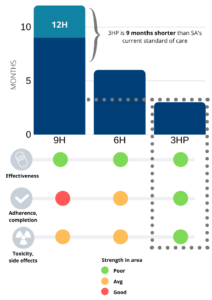Finding and treating people with tuberculosis is critical to slow the disease. Preventing it in the first place will help end the epidemic.
We can prevent and cure tuberculosis. But based on current rates, it will take over 100 years. A far cry from the goals set out by the World Health Organization’s (WHO) End TB Strategy, which aims to reduce global TB deaths by 95 percent and incidence by 90 percent by 2035.
TB is the number one infectious killer, and among the top 10 causes of death globally. In 2017 alone, there were 10 million new cases and 1.6 million deaths worldwide.
Nearly all cases happen in low- and middle-income countries, where health systems often don’t have the capacity to find and treat people with the disease. Even when people are diagnosed, they can struggle to stay on the treatment regimen, which is long and difficult.
In addition, the WHO estimates that a quarter of people globally are living with latent (or non-infectious) TB. They have a five to 15 percent risk of becoming ill from the disease in their lifetimes. People with weaker immune systems, such as those living with HIV or children, are particularly vulnerable.
We are working with our partners and governments to change this.
If we can find more people living with TB and treat them before they are able to transmit the disease to others, as well as better manage drug-resistant strains and protect the most vulnerable through preventative medicines, then we can end this epidemic.
Preventing the disease in our most vulnerable
Key to ending the epidemic is reducing the incidence of TB. We are working to prevent latent TB from becoming active, with a focus on protecting those most at risk.
By treating latent TB infection, we can prevent thousands of people from developing the disease— and ultimately save lives.
To this end, we are helping our partners in Africa and Asia Pacific introduce new preventive therapies, like 3HP, a short-course treatment regimen to prevent the development of active TB. The rollout of 3HP in our partner countries is focused on high risk groups, namely people living with HIV and children under five, and subsequently all those in close contact with TB patients.
What is 3HP?
Treatment for latent TB infection has been available since the 1960s, yet very few people who are eligible for preventive therapy are taking it. Treatment is long— with people required to take a pill every day for 6 to 36 months. Even among those who start treatment, many fail to complete the full course.
In 2016, only 12 of the 30 countries with the highest burden of the disease reported use of the current treatment of choice for latent TB – Isoniazid Preventive Therapy (IPT). Common IPT treatment regimens under recommended guidelines include the use of six months of daily isoniazid (INH; 6H); nine months of daily INH (9H); and twelve months of daily INH (12H).
3HP treats latent TB much more quickly than these therapies.
The 3HP regimen is a once weekly dose of INH and rifapentine (RPT) taken for three months. Studies have shown that compared to IPT, 3HP has lower rates of adverse events, higher adherence, better completion rates, as well as overall better clinical outcomes. That is why it is recommended as an alternative to longer regimens for people living with HIV and children in contact with people with infectious TB, in the WHO’s latest guidelines, which were released today.
The South African example
In South Africa, we are working with the government to roll out 3HP to replace IPT (12H), the current standard of care for people living with HIV.
South Africa is among a handful of countries that has a triple high burden of drug-sensitive TB, drug-resistant TB (DR-TB), which is resistant to the most effective first-line medications, and HIV.
Treating people with latent TB is the best way to reduce the burden of TB and protect people living with HIV in South Africa, as well as other vulnerable populations, like children. But keeping people on treatment is difficult, with the average completion rate for 12H sitting at just 65 percent.
In 2018, CHAI helped the National Department of Health deliver the investment case for the introduction of 3HP nationally. 3HP has been shown to be just as effective as the standard therapy, with fewer side effects for patients and a higher adherence rate thanks to the shorter and easier regimen.

Figure 1. Clinical argument for 3HP in South Africa.
It also showed that 3HP was more cost effective than the current therapy. The total number of people on IPT in South Africa in 2018 was approximately 480,000. At the current price, treating those patients with 3HP instead will save the government about US$40 million over the three years it will take to roll out the updated program.
This is because the shorter length of 3HP means that each patient is required to attend fewer consultations and consequently uses less healthcare worker capacity. So while the cost of drugs for 3HP and IPT in South Africa are almost the same, the cost of care is significantly lower for 3HP, translating into a lower total cost of treatment per patient.
3HP offers potentially huge savings on service delivery and treatment of active TB (by averting more of those cases). The results informed the department’s decision to scale up the new treatment.
Rolling out the model across countries
We are working with partners in other countries to roll out the model tested in South Africa and prevent thousands more TB cases. In Cambodia, Kenya, India, and Zimbabwe under the IMPAACT4TB Project (Increasing Market and Public health outcomes through scaling up Affordable Access models of short Course preventive therapy for TB), we are working with governments to introduce this medication through updating national guidelines, supporting product registration, and designating sentinel sites, alongside development of forecasting tools, training health providers, and ensuring supply chains are ready.





